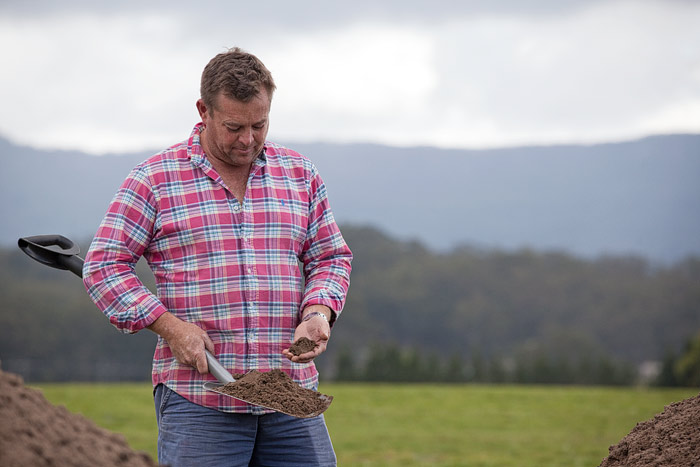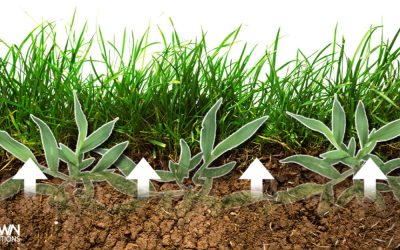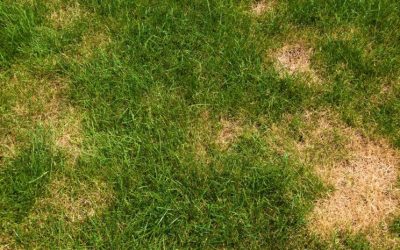The Ultimate Guide to Improving Lawn Drainage
Quick Links
Improving Lawn Drainage
A lush, healthy lawn is a source of pride for homeowners, but one common issue that can hinder its beauty and health is poor drainage.
Excess water pooling on your lawn can lead to various problems, such as waterlogging, root rot, and a decline in overall turf quality.
As well as killing your lawn, a waterlogged yard can also lead to an increase in mosquitoes and other pests.

If your lawn doesn’t drain well after rain, this guide is for you. Find out common lawn drainage problems, how to get better lawn drainage and how to install a drainage system.
Common lawn drainage problems
Standing water, mushy areas, and basement leaks are all signs of yard drainage issues.
In this section, we will discuss common water problems and the drainage solutions that can correct them and help prevent further damage to your property.
1. Standing water
Have you ever noticed water pooling in your yard after a heavy summer rainstorm or a few consecutive rainy days?
If so, you probably have a lawn drainage problem. Standing water is typically caused by poor lawn sloping and inadequate soil drainage.
To address this issue, consider the following solutions:
- Add topsoil to level out low areas.
- Incorporate sand and compost into your soil to aid in draining.
- Install a trench drain to channel standing water away.
2. Poor lawn sloping
If your lawn isn’t properly graded for sufficient water runoff, it can lead to standing water and potential leaks into your basement area.
Homes situated at the bottom of slopes or hills are particularly susceptible to water runoff.

To correct this issue, you may need to regrade your lawn:
- Lower the high areas and fill in the lower ones with a landscape rake.
- Achieve the correct slope away from your home, ideally 2 to 3 inches every 10 feet.
- Consult a professional landscaper if needed for proper regrading.
3. Gutter and downspout runoff
Gutters and downspouts can contribute to excess water in your yard if they are clogged, undersized, or not diverting rainwater properly. This can result in water gathering along your home’s foundation, patios, and driveways.
Consider the following solutions:
- Clean your gutters regularly, especially if you live in a bush area.
- Install downspout extensions to channel rainwater further away from your home’s foundation.
- Use splash blocks to improve the control of downspout runoff.
4. Patio and driveway water pooling
Incorrect slope and the absence of water channels can lead to excess water puddling around your patio or driveway.
If you observe standing water around the surface edges, you can implement the following solutions:
- Install a trench or channel drain to help move water along.
- Add a decorative gravel edge or border to facilitate water drainage.
How To Get Better Drainage In Your Lawn
There are several things you can do to improve drainage in your lawn. Some of these methods are relatively simple and can be done yourself, while others may require the help of a professional.
Simple methods can include aerating your lawn, adding sand and removing debris. However, more complex drainage solutions include:
- Install a French drain system. This is a trench filled with gravel that helps to collect and divert water away from your lawn.
- Install a sump pump. This is a pump that removes water from your basement or crawl space. It can also be used to remove water from your lawn.
- Regrade your yard. This involves sloping your yard so that water will flow away from your house and towards a drainage system.
How to improve drainage in clay soil lawns
Clay soil presents unique challenges when it comes to drainage as its naturally dense and compact. However, with the right strategies, you can improve drainage and your lawn.
Here are 4 ways you can improve drainage in clay soils.
1. Condition the soil
This can be done by adding organic matter, such as compost, to the soil. Organic matter helps to break up the clay particles and improve the soil’s ability to drain water.
2. Aerate the lawn
This involves creating small holes in the soil, which allows water to drain more easily. You can aerate your lawn with a hollow-tine aerator or a garden fork.
3. Drill holes
This is a more permanent solution than aeration, and it involves drilling holes in the soil at regular intervals. The holes should be about 15cm deep and 2.5cm in diameter.
4. Topdress the lawn
This involves adding a layer of sand or compost to the top of the lawn. This helps to improve the soil’s drainage and aeration.
5. Plant drought-tolerant grasses
If your lawn is prone to waterlogging, you may want to consider planting drought-tolerant grasses. These grasses are better able to tolerate wet conditions and will not suffer as much damage from waterlogging.
To prevent waterlogging you should also rake up leaves and debris from your lawn, make sure not to overwater your lawn and consider installing a french drain or other drainage system.
Does Aerating Lawn Help Drainage
Aeration is a commonly recommended practice to improve lawn health, but how does it impact drainage specifically?
When the soil is compacted, it becomes harder for water to drain. This can lead to waterlogging, which can damage the grassroots and make the lawn more susceptible to weeds.
Aerating the lawn helps to break up the compacted soil and create channels for water to drain.
Aeration is the process of creating small holes in the soil, which allows air, water, and nutrients to reach the grassroots.
In addition to improving drainage, aeration also helps to improve the health of the grassroots.
When the grassroots have access to more air and water, they are better able to absorb nutrients and grow strong. This results in a healthier, more vibrant lawn.
Some additional benefits of aerating your lawn include:
- It helps to reduce thatch buildup. Thatch is a layer of dead and decaying grass that can build up on the surface of your lawn. It can block water and air from reaching the grassroots, which can lead to problems such as waterlogging and disease.
- It helps to improve the infiltration of water. This means that water will soak into the soil more easily, which can help to prevent runoff and erosion.
- It helps to improve the oxygen levels in the soil. This is important for the growth of healthy grassroots.

Does Sand Help Lawn Drainage
Sand is a good drainage agent because it has large pores that allow water to flow through easily. This is in contrast to clay, which has small pores that can trap water.
When sand is added to clay soil, it helps to break up the clay particles and create larger pores. This allows water to drain more easily and prevents waterlogging.
In addition to improving drainage, sand can also help to improve the overall health of the lawn.
Sand helps to retain moisture, which can help the grass to stay healthy during dry periods. Sand also helps to suppress weeds, as weeds prefer compacted soil.
If you are looking for a way to improve the drainage of your lawn, sand is a good option. It is a simple and effective way to help your lawn thrive.
How To Add Drainage To Lawn
Drainage basins can help to solve water drainage problems by diverting standing water away from your property and into a storm drain or other collection area.
The final section of this text will provide step-by-step instructions for adding drainage to your lawn.
1. Locate the problem areas
This is where the water is pooling or standing. You will need to identify the lowest point in this area as well as where the outlet will be (ie, where your drainage system will lead to).
2. Dig a trench
Start at the spot designated for the outlet and dig a trench back to the problem area. The trench should be at least 30cm deep and 15cm wide and have a consistent slope from beginning to end. Be careful to keep the trench bottom flat so you don’t have high spots in the pipe that may hamper the flow of water.
3. Add gravel to the bottom of the trench
The gravel will help to collect the water and prevent it from clogging the drain.
4. Place the drain pipe in the trench
The pipe should slope slightly so that the water will flow towards the outlet.
5. Install an outlet for the drain pipe
The outlet can be a storm drain, a sump pump, or a dry well. Before installing the basin, place 6 inches of gravel under the basin to eliminate standing water. The basin grate should be flush with or slightly below the surrounding soil grade.
6. Test the drain line
Test the drain by running water into the basin with a hose. If the system doesn’t drain, make the appropriate adjustments to the trench.
7. Cover the pipe with gravel
The gravel will help to protect the pipe from damage and keep it in place.
8. Backfill the trench
Be sure to tamp the sand and soil down firmly so that it will not collapse.
Achieving proper lawn drainage is essential for maintaining a healthy and beautiful outdoor space.
By following the techniques and strategies outlined in this comprehensive guide, you can address both general and clay soil-specific drainage issues.
Remember, successful drainage improvement involves a combination of factors such as grading, drainage systems, soil amendments, aeration, and thoughtful plant selection.
With dedication and proper implementation, you can transform your lawn into a well-drained haven for flourishing greenery.
read more!
recent posts
What is the Best Grass for a Lawn? A Complete Guide to Top Choices
Discover the best grass options for your lawn with our complete guide. Make informed choices for a lush, healthy yard. Read more to find your ideal grass!
Choosing the Right Weed Killer for Your Sir Grange Zoysia Lawn
Discover the best weed killer for Sir Grange Zoysia and essential tips for effective application. Enhance your lawn’s health and beauty!
Why Is My Zoysia Grass Dying? Common Causes and Solutions to Revive It
Is your Zoysia grass struggling? Discover common causes of decline and effective solutions to restore its health. Read the article for expert tips!

Our Turf
TifTuf Bermuda
Buy Turf Online © 2019 All Rights Reserved. | Proudly Designed and Developed by Sydney ICT



